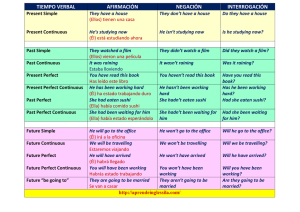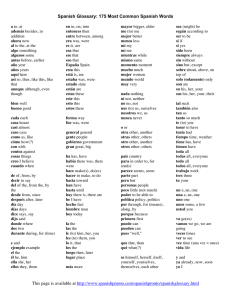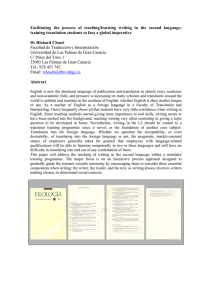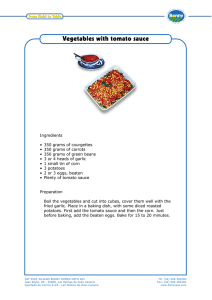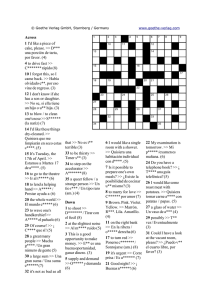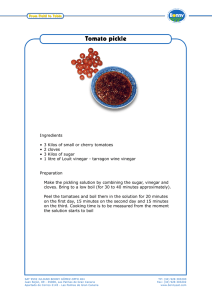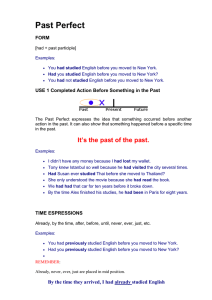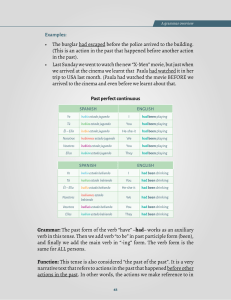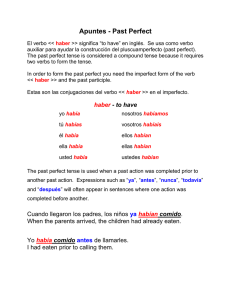Spatial Meaning is Retained in Emotion Metaphors: Some Evidence
Anuncio
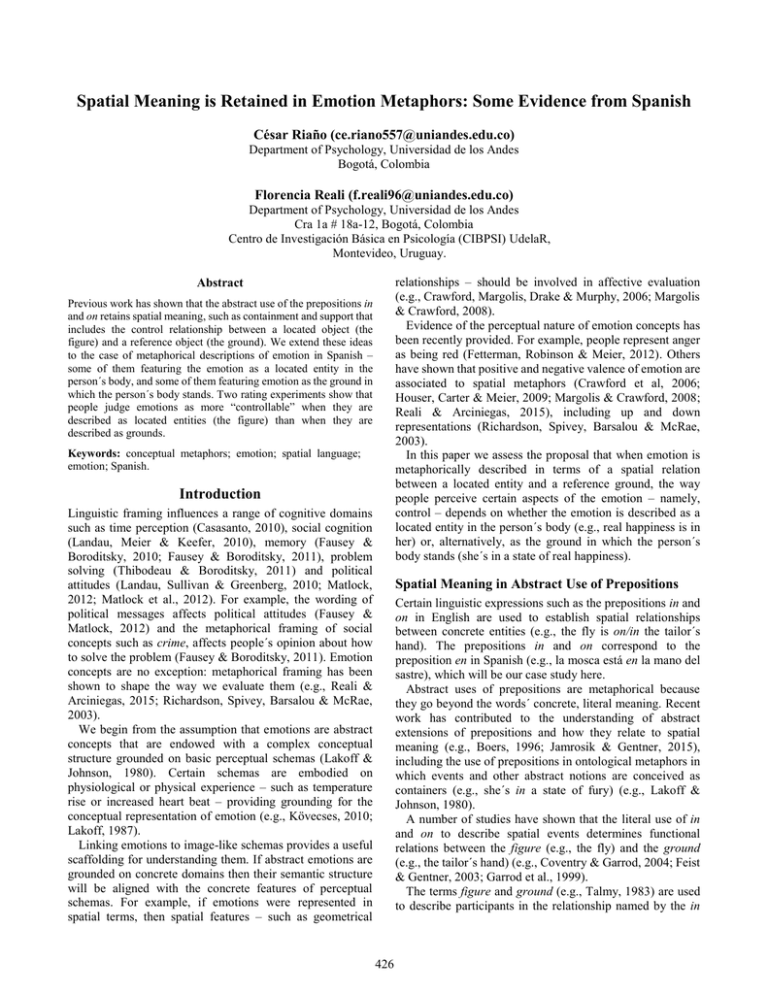
Spatial Meaning is Retained in Emotion Metaphors: Some Evidence from Spanish César Riaño ([email protected]) Department of Psychology, Universidad de los Andes Bogotá, Colombia Florencia Reali ([email protected]) Department of Psychology, Universidad de los Andes Cra 1a # 18a-12, Bogotá, Colombia Centro de Investigación Básica en Psicología (CIBPSI) UdelaR, Montevideo, Uruguay. relationships – should be involved in affective evaluation (e.g., Crawford, Margolis, Drake & Murphy, 2006; Margolis & Crawford, 2008). Evidence of the perceptual nature of emotion concepts has been recently provided. For example, people represent anger as being red (Fetterman, Robinson & Meier, 2012). Others have shown that positive and negative valence of emotion are associated to spatial metaphors (Crawford et al, 2006; Houser, Carter & Meier, 2009; Margolis & Crawford, 2008; Reali & Arciniegas, 2015), including up and down representations (Richardson, Spivey, Barsalou & McRae, 2003). In this paper we assess the proposal that when emotion is metaphorically described in terms of a spatial relation between a located entity and a reference ground, the way people perceive certain aspects of the emotion – namely, control – depends on whether the emotion is described as a located entity in the person´s body (e.g., real happiness is in her) or, alternatively, as the ground in which the person´s body stands (she´s in a state of real happiness). Abstract Previous work has shown that the abstract use of the prepositions in and on retains spatial meaning, such as containment and support that includes the control relationship between a located object (the figure) and a reference object (the ground). We extend these ideas to the case of metaphorical descriptions of emotion in Spanish – some of them featuring the emotion as a located entity in the person´s body, and some of them featuring emotion as the ground in which the person´s body stands. Two rating experiments show that people judge emotions as more “controllable” when they are described as located entities (the figure) than when they are described as grounds. Keywords: conceptual metaphors; emotion; spatial language; emotion; Spanish. Introduction Linguistic framing influences a range of cognitive domains such as time perception (Casasanto, 2010), social cognition (Landau, Meier & Keefer, 2010), memory (Fausey & Boroditsky, 2010; Fausey & Boroditsky, 2011), problem solving (Thibodeau & Boroditsky, 2011) and political attitudes (Landau, Sullivan & Greenberg, 2010; Matlock, 2012; Matlock et al., 2012). For example, the wording of political messages affects political attitudes (Fausey & Matlock, 2012) and the metaphorical framing of social concepts such as crime, affects people´s opinion about how to solve the problem (Fausey & Boroditsky, 2011). Emotion concepts are no exception: metaphorical framing has been shown to shape the way we evaluate them (e.g., Reali & Arciniegas, 2015; Richardson, Spivey, Barsalou & McRae, 2003). We begin from the assumption that emotions are abstract concepts that are endowed with a complex conceptual structure grounded on basic perceptual schemas (Lakoff & Johnson, 1980). Certain schemas are embodied on physiological or physical experience – such as temperature rise or increased heart beat – providing grounding for the conceptual representation of emotion (e.g., Kövecses, 2010; Lakoff, 1987). Linking emotions to image-like schemas provides a useful scaffolding for understanding them. If abstract emotions are grounded on concrete domains then their semantic structure will be aligned with the concrete features of perceptual schemas. For example, if emotions were represented in spatial terms, then spatial features – such as geometrical Spatial Meaning in Abstract Use of Prepositions Certain linguistic expressions such as the prepositions in and on in English are used to establish spatial relationships between concrete entities (e.g., the fly is on/in the tailor´s hand). The prepositions in and on correspond to the preposition en in Spanish (e.g., la mosca está en la mano del sastre), which will be our case study here. Abstract uses of prepositions are metaphorical because they go beyond the words´ concrete, literal meaning. Recent work has contributed to the understanding of abstract extensions of prepositions and how they relate to spatial meaning (e.g., Boers, 1996; Jamrosik & Gentner, 2015), including the use of prepositions in ontological metaphors in which events and other abstract notions are conceived as containers (e.g., she´s in a state of fury) (e.g., Lakoff & Johnson, 1980). A number of studies have shown that the literal use of in and on to describe spatial events determines functional relations between the figure (e.g., the fly) and the ground (e.g., the tailor´s hand) (e.g., Coventry & Garrod, 2004; Feist & Gentner, 2003; Garrod et al., 1999). The terms figure and ground (e.g., Talmy, 1983) are used to describe participants in the relationship named by the in 426 and on prepositions in English and the proposition en in Spanish. For example, the fly (the located entity, the figure) is in the soup (the ground). Crucially, the use of the prepositions in and on is based on the principle of control of the figure by the ground. The basic idea is that functional relations, such as containment, entail inferences beyond geometric relations: if a figure is contained by a ground it can be inferred that if the ground moves, the figure moves with it (Garrod & Sanford, 1989; Jamrozik & Gentner, 2015). In English, because the use of in denotes geometric inclusion or containment, it involves greater ground control than does on (Coventry & Garrod, 2004; Garrod, et al, 1999). Garrod and Sanford (1989) and, more recently, Jamrozik and Gentner (2015) proposed that the functional relations of containment and support might be extended to non-spatial (abstract) uses of in and on (e.g., she´s in a risky situation). They proposed that the metaphorical use of in and on helps establish the relative degree of control between an abstract object (the figure) and an abstract reference object (the ground). A natural proposal that follows from these studies is that when the prepositions in and on are used to describe emotions certain control relations may be inferred. Garrod and Sanford (1989) even suggested that metaphorical framing of emotion (e.g., she´s in a bad mood), follows the same pattern. To our knowledge, however, this proposal has not been empirically tested for the case of emotion. The goal of this study is to assess empirically if spatial meaning – namely, the control relationship between the figure and the ground – is retained when metaphorical expressions of emotion are used. (you must/should not fall into despair) (Reali & Arciniegas, 2015, p. 28). In this example, “despair” corresponds to the ground and “you” corresponds to the figure. Conversely, consider “Gracián corrió hacia la iglesia totalmente enloquecido lleno de odio” (Gracián ran towards the church totally insane, full of hate) (Reali & Arciniegas, 2015, p. 30). In this example hate corresponds to the entity (the figure) inside Gracián (the ground). Figure 1. Emotions as located objects (the figure) in a ground (the person´s body) (left) and emotions as places (the ground) in which the person´s body (the figure) stands (right). Expressions of this kind are common in Spanish, providing a nice case study to test the proposal that concrete properties of physical ground-figure settings – namely the control relationship between the figure and the ground– is preserved in the semantic structure of emotion. That is precisely the aim of this paper. The prediction to be tested is the following: if spatial meaning is retained in metaphors of emotion, then when emotion is described as a located entity contained in the person´s body, a higher perception of emotion controllability should be found than when emotion is described as a ground in which the person´s body stands. Two questionnaire experiments were conducted to assess this hypothesis. To preview, the results show that metaphorical forms in which emotion is described as the located figure is associated to higher ratings of controllability. Figure/Ground Relation in Metaphors of Emotion The studies described above suggest that the control relationship between the figure and the ground are mapped from concrete to abstract domains. In this paper we use the Spanish preposition en to frame emotion metaphorically either as a located entity (the figure) in a ground (the body of the person´s experiencing the emotion) vs. as a place (the ground) containing a located object (the person´s body). We assess whether metaphor framing affects how controllable people judge emotion to be. Lakoff (1987) proposed that emotions are grounded on primary metaphors such as THE BODY IS A CONTAINER FOR EMOTIONS and EMOTIONS ARE BOUNDED SPACES. The first metaphor conveys emotions as located entities (the figure) in a container (the person´s body), while the second conveys emotions as grounds in which the person stands. Figure 1 depicts a sketch of possible conceptual schemas associated with these two primary metaphors. Because of the concrete nature of spatial schemas, these are good metaphor examples to study the effect of image-like representations on the conceptualization of emotion. Corpus analyses have shown that linguistic instantiations of these metaphors are quite common in Spanish (e.g., Reali & Arciniegas, 2015; Reali, Soriano & Rodriguez, in press). Consider the expression “no has de caer en la desesperación” Study 1 Study 1 was designed to explore whether the instantiations of emotion-as-ground vs. emotion-as-figure metaphors influence people’s judgments of emotion control. The experiment was inspired by Jamrozik & Gentner (2015). Participants saw sentences describing situations involving a person experiencing a certain emotion as well as a cause or context. They were asked to rate the degree of control they thought the person had over the emotion. The metaphorical framing of emotion was manipulated so that emotion was described as the located figure (emotion-as-figure condition) or as the ground (emotion-as-ground condition). 427 used in the experimental items and had a different (not metaphorical) structure as the twelve experimental items. The questionnaire was presented on paper and the data was annotated manually. Method Participants A hundred and eight undergraduate students from Universidad de los Andes (Bogotá, Colombia) volunteered to participate in this Study or received extra course credits in exchange of their participation. All participants were 18 years-old or older and declared that their native language was Spanish. Results of Study 1 One of the participants was removed from the sample because he did not complete the questionnaire. This was a within subject design (each subject was exposed to both conditions) and conditions were counterbalanced across items. Each participant was exposed to one version of the item only. Ratings of perceived control were higher in the emotion-as-figure condition (M = 3.86; SD= .86) than in the emotion-as-ground condition (M = 3.68; SD=.85), and the difference was significant both by subjects (two-tailed t(107) = 2.36; p=.02) and by items (two tailed t(11) = 2.33; p =.04). As predicted, the results of Study 1 suggest that participants rated emotions as more controllable when they are described as figures in grounds compared to when they are described as grounds holding figures. Materials For both experiments the stimuli consisted of twelve sentence items gathered in one questionnaire. Each participant was presented with one of two version of each item, which consisted on a description of a fake situation of a person experiencing an emotion as well as a context for it. The two versions of each item differed only in the choice of metaphorical framing. In one condition, the emotion was framed as a located entity (the figure) in the human body (the ground), and in the second condition it was described as the place (the ground) in which the human body (the figure) is located. Each item included one of the following emotions: alegría (joy), ansiedad (anxiety), enamoramiento (infatuation), esperanza (hope), felicidad (happiness), furia (fury), ira (anger), locura (madness), miedo (fear), serenidad (serenity), tristeza (sadness), verguenza (shame). Example (1) illustrates a sentence item in the two conditions (a full list is included in the appendix). (1) a. La oscuridad del monte se acentuaba por la falta de luz de luna; había en Elena un gran miedo. (tr. The darkness in the woods was accentuated by the lack of moonlight; there was great fear in Elena) b. La oscuridad del monte se acentuaba por la falta de luz de luna; Elena se encontraba en un estado de gran miedo. (tr. The darkness in the woods was accentuated by the lack of moonlight; Elena was in a state of great fear) Study 2 A possible caveat of Study 1 is that emotion valence was not manipulated in a systematic manner. It could be the case that evaluation of emotion controllability differs significantly depending on whether the emotion is positive or negative in valence. Moreover, Study 1 materials included 5 positive emotions and 7 negative emotions, thus hindering fair comparisons between ratings per valence. Study 2 was designed to address this problem: intended as an improved replication of Study 1, the set of materials included 12 positive and 12 negative emotions. Additionally, items were rated for naturalness in an independent control experiment. Study 2 followed a 2x2 design; Factor 1 Metaphor Framing (emotion-as-figure/ emotion-as-ground) and Factor 2 Valence of Emotion (positive/negative). Valence of Emotion was varied between subjects, and Metaphor Framing was varied within subjects as in Study 1. Sentence 1a corresponds to the first condition (emotion-asfigure condition) while sentence 1b corresponds to the second condition (emotion-as-ground condition). Method Procedure Two questionnaire lists with twelve experimental items were created. Questionnaires were randomized across participants and the two conditions were counterbalanced across lists so that each participant only saw one version of each item. The order of items were pseudo-randomized across participants to avoid order effects. Participants were asked to rate the situation described in each sentence on a scale from 1 to 7. They were instructed to judge, for each situation described, the degree of control the person had on the emotion. The scale was defined so that 1 indicated “the person has very little control over their emotion” and 7 “the person has total control over their emotion”. The questionnaire began with a page of instructions asking participants to make their judgments based on first impressions without reading each sentence more than once. In the instructions, participants were given two practice items. The practice included two emotions not Participants A hundred and twenty four undergraduate students from Universidad de los Andes (Bogotá, Colombia) volunteered to participate in this study or received extra course credits in exchange of their participation. All participants were 18 years-old or older and declared that their native language was Spanish. Materials The stimuli consisted of twelve sentences each describing a person experiencing a negative emotion and twelve sentences describing a person experiencing a positive emotion. Sentences describing positive and negative emotions were gathered in two different questionnaires. Each participant was presented with one of these two questionnaires. As in Study 1, there were two versions of each sentence, varying on the choice of metaphorical framing. In one condition, the emotion was framed as a 428 Emotion was also significant (F (1,121) = 68.1; p <.0001; η2 = .36). However, the interaction between Valence of Emotion and Metaphor Framing was not significant (F<.5; p=.9). located figure in a container (the person´s body), while in the second condition it was metaphorically described as a ground in which the person is. The twelve negative emotions were: angustia (anguish), ansiedad (anxiety), decepción (disappointment), desconsuelo (desolation), desesperanza (hopelessness), entusiasmo (enthusiam), furia (fury), ira (anger), locura (madness), miedo (fear), resignación (abandonment), tristeza (sadness) verguenza (shame). The twelve positive emotions were the following: alegría (joy), alivio (relief), enamoramiento (infatuation), esperanza (hope), exaltación (excitation), felicidad (happiness), júbilo (rejoice), orgullo (pride), satisfacción (satisfaction), serenidad (serenity), tranquilidad (tranquility). A full list of items is included in the appendix. Additionally, Study 2 sentence items were controlled for naturalness of sentences in the two metaphor conditions using an independent sample. We collected naturalness ratings of the twenty four sentences in a separate test. One hundred and twelve participants (who did not participate in the experimental task) rated the naturalness of the 24 experimental sentences. Each participant saw one version of each sentence and conditions were counterbalanced across subjects. Participants rated each sentence’s naturalness on a scale from 1 (not at all natural) to 7 (extremely natural). The sentences did not differ in their naturalness (M (emotion-asfigure) = 4.70, SD = 1.27, M (emotion-as-ground) = 4.74, SD = 1.28, t(111) = 0.83, p = .40). Control Rating 5 4 3 2 Negative emotions emotion-figure Positive emotions emotion-ground Taken together, the results of Study 1 and Study 2 suggest that participants rate emotions as more controllable when they are described as figures in grounds than when they are described as grounds. Additionally, people rate positive emotions as more controllable than negative, but this effect seems to be independent of the metaphorical mapping on figure/ground settings. Discussion The data suggests that the metaphorical framing of emotions affects the participants´ evaluation of degree of control. This is consistent with the proposal that the spatial relationships in figure/ground schemas are retained in abstract representations of emotion: when emotion is described as a located entity in the human body, the emotion is rated as more controllable. One implication of these findings is related to the effect of the abstract use of prepositions on semantic structure. In line with studies of the abstract use of in and on in English (e.g., Jamrazik & Gentner, 2015), our data provides empirical evidence that the metaphorical use of en in Spanish preserves spatial meaning of functional relations such as control. More generally, the data provides support to the view that perceptual schemas underlie the abstract concepts of emotion. This is consistent with accumulating work linking emotions to perceptual, image-like schemas (e.g., Crawford, Margolis, Drake & Murphy, 2006; Margolis & Crawford, 2008), adding to the evidence of the perceptual nature of emotion representation (Crawford et al, 2006; Fetterman, Robinson & Meier, 2012; Houser, Carter & Meier, 2009; Margolis & Crawford, 2008; Reali & Arciniegas, 2015; Richardson, Spivey, Barsalou & McRae, 2003). Finally, this work supports the view that thought is shaped by language. It adds to the many papers showing that linguistic framing influences a range of cognitive domains from perception to social cognition (e.g., Landau, Meier & Keefer, 2010; Fausey & Boroditsky, 2010; Fausey & Boroditsky, 2011; Thibodeau & Boroditsky, 2011; Matlock, 2012). In sum, different aspects of spatial meaning embedded in figure-ground relationships seem to be retained in the way Procedure Four questionnaire lists with twelve experimental items were created, two containing sentences featuring positive emotion and two containing sentences featuring negative emotions. Questionnaires were randomized across participants and the two conditions were counterbalanced across lists so that each participant only saw one version of each item. As in Study 1, the order of items were pseudorandomized across participants to avoid order effects. Other aspects of the procedure and instructions were the same as in Study 1. Results of Study 2 One of the participants was removed from the sample because he did not complete the questionnaire. As in Study 1, Metaphor Framing was a within-subject condition. Emotion valence was a between subject condition since each participant was exposed to one questionnaire containing either positive or negative emotions. Results are shown in Figure 2. The main finding of Study 1 was replicated: ratings of perceived control over emotions were higher in the emotion-as-figure condition (M=4.33; SD=1.08) than in the emotion-as-ground condition (M= 4.15; SD=1.05). Also, ratings were higher for positive emotion (emotion-as-figure, M= 4.94; SD=0.93; emotion-as-ground, M=4.76; 0.94) than negative emotions (emotion-as-figure, M= 3.72; SD=0.87; emotion-as-ground, M=3.53; 0.80). A repeated measures ANOVA revealed that the effect of Metaphor-Framing condition was significant (F (1,121) = 8.97; p = 0.003; η2= .07) and that the effect of Valence of 429 concepts of emotion are construed. Kövecses, Z. (2010). Metaphor and culture. Acta Univesitatis Sapientiae Philologica, 2, 197–220. Acknowledgments Lakoff, G. (1987). Women, fire and dangerous things. Chicago, IL: Chicago University Press. Lakoff, G., & Johnson, M. (1980). Metaphors we live by. Chicago, IL: Chicago University Press. Landau, M. J., Meier, B., & Keefer, L. (2010). A metaphorenriched social cognition. Psychological Bulletin, 136, 1045–1067. Landau, M.J., Sullivan, D., & Greenberg, J. (2009). Evidence that self-relevant motivations and metaphoric framing interact to influence political and social issues. Psychological Science, 20, 1421–1427. Lleras, M., Reali, F. & Alviar, C (2014). The metaphors we speak with affect how we think about time and space. In Bello P., Guarini, M., McShane M. & Scassellati B. (Eds.) Proceedings of the 36th Annual Conference of the Cognitive Science Society (pp. 1258-1264). Austin TX: Cognitive Science Society. Margolis, S.O., & Crawford, L.E. (2008). Event valence and spatial metaphors of time. Cognition & Emotion, 22, 1401– 1414. Matlock, T. (2012). Framing political messages with grammar and metaphor. American Scientist, 100, 478–483. Matlock, T., Sparks, D., Matthews, J. L., Hunter, J., & Huette, S. (2012). Smashing new results on aspectual framing: How people describe car accidents. Studies in Language, 36, 700–721. Reali, F. & Arciniegas, C. (2015). Metaphorical conceptualization of emotion in Spanish: Two studies on the role of framing. Metaphor and Social World, 5(1), 2042. Reali, F., Soriano, T., & Rodríguez, D. (in press). How we think about depression: The role of metaphorical framing. To appear in Revista Latinoamericana de Psicología. Richardson, D. C., Spivey, M. J., Barsalou, L. W., & McRae, K. (2003). Spatial representations activated during realtime comprehension of verbs. Cognitive Science, 27, 767– 780. Thibodeau, P., & Boroditsky, L. (2011). Metaphors we think with: the role of metaphor in reasoning. PLoS ONE 6(2): e16782. Talmy, L. (1983). How language structures space. In H. Pick & L. Acredolo (Eds.), Spatial orientation: Theory, research, and application. New York: Plenum Press. We thank Debora Shambo as well as other members from the Language and Cognition lab at Universidad de los Andes for their help on the data recollection process. This research was funded by the Fondo de Apoyo para Profesores Asistentes (FAPA), Vicerrectoría de Investigaciones, Universidad de Los Andes, Bogotá, Colombia. References Boers, F. (1996). Spatial prepositions and metaphor: A cognitive semantic journey along the up-down and the front-back dimensions. Tubingen, Germany: Gunter Narr Verlag. Boroditsky, L. (2000). Metaphorical structuring: understanding special metaphors. Cognition, 75(1), 1-28. Boroditsky, L. & Ramscar, M. (2002). The roles of body and mind in abstract thought. Psychological Science, 13(2), 185-189. Casasanto, D. (2010). Space for thinking. In B. Bergen, V. Evans & J. Zinken (Eds.), Language, cognition and space: State of the art and new directions (pp. 453–461). London: Equinox. Crawford, L. E., Margolis, S. M., Drake, J. T., & Murphy, M. E. (2006). Affect biases memory of location: Evidence for spatial representation of affect. Cognition & Emotion, 20, 1153–1169. Fausey, C. M., & Boroditsky, L. (2011).Who dunnit? Crosslinguistic differences in eye-witness memory. Psychonomic Bulletin & Review, 18, 150–157. Fausey, C. M., & Boroditsky, L. (2010). Subtle linguistic cues influence perceived blame and financial liability. Psychonomic Bulletin & Review, 17(5), 644–650. Fausey, C. M., & Matlock, T. (2011). Can grammar win elections? Political Psychology, 32, 563–574. Feist, M. I., & Gentner, D. (2003). Factors involved in the use of in and on. In R. Alterman & D. Kirsh (Eds.), Proceedings of the twenty-fifth annual meeting of the cognitive science society (pp. 390–395). Hillsdale, NJ: Lawrence Erlbaum. Fetterman, A.K., Robinson, M.D., & Meier, B.P. (2012). Anger as “seeing red”: Evidence for a perceptual association. Cognition & Emotion, 26, 1445–1458. Gentner, D. & Goldin-Meadow, S. (2003). Whither Whorf. In D. Gentner and S. Goldin-Meadow (Eds), Language in mind: Advances in the study of language and thought. Cambrige, MA: MIT Press. Hauser, D. J., Carter, M. S., & Meier, B. P. (2009). Mellow Monday and furious Friday: The approach-related link between anger and time representation. Cognition & Emotion, 23, 1166–1180. Jamrozik, A. & Gentner, D. (2015). Well-hidden regularities: Abstract uses of in and on retain an aspect of their spatial meaning. Cognitive Science, 39, 1881-1911. APPENDIX Experimental sentences used in Study 2. Those marked with a star (*) are the items used in Study 1. emotion-as-ground condition: X se encontraba en un estado de gran Y X (person) was in a state of great Y (emotion) emotion-as-figure condition: Había un gran Y en X There was great Y (emotion) in X (person) 430 4. Había sido víctima de un robo colosal; Roberto se encontraba en un estado de gran desesperanza/ había en Roberto una gran desesperanza. X=Roberto, Y=desesperanza (hopelessness) 5. Los resultados de sus exámenes de sangre no estaban listos; Lucía se encontraba en un estado de gran angustia/ había en Lucía una gran angustia. X=Lucía, Y=angustia (anguish) *6. Faltaban cinco minutos para que salieran a luz los resultados del examen; Camilo se encontraba en un estado de gran ansiedad/ había en Camilo una gran ansiedad. X=Camilo, Y=ansiedad (anxiety) *7. La muerte de su perro fue inesperada; Salomé se encontraba en un estado de gran tristeza/ había en Salomé una gran tristeza. X=Salomé, Y=tristeza (sadness) 8. Su novia mostraba desinterés frente a un posible futuro juntos; Jaime se encontraba en un estado de gran decepción/ había en Jaime una gran decepción. X=Jaime, Y=decepción (disappointment) 9. La falta de soluciones a sus problemas era evidente; Rocío se encontraba en un estado de gran resignación/ había en Rocío una gran resignación (abandonment). *10. La infidelidad de su esposa salió a la luz; Marcos se encontraba en un estado de gran furia/ había en Marcos una gran furia. X=Marcos, Y=furia (fury) *11. El fallo de la corte había sido injusto; Ximena se encontraba en un estado de gran ira/ había en Ximena una gran ira. X=Ximena, Y=ira (anger) 12. Sus enemigos lograron acabar con su compañía; Martín se encontraba en un estado de gran desconsuelo/ había en Martín un gran desconsuelo. X=Martín, Y=desconsuelo (desolation) Positive valence items 1. Las notas finales reflejaron su esfuerzo; María se encontraba en un estado de gran satisfacción/ había en María una gran satisfacción. X = María, Y= satisfacción (satisfaction) 2. La policía recuperó la mayoría de sus pertenencias; Alison se encontraba en un estado de gran alivio/ había en Alison un gran alivio. X = Alison, Y= alivio (relief) 3. Se acercaba su fiesta de cumpleaños por fin; Freddy se encontraba en un estado de gran exaltación/ había en Freddy una gran exaltación. X = Freddy, Y= exaltación (excitement) *4. Llegaron buenas noticias por fin; Malena se encontraba en un estado de gran alegría/ había en Malena una gran alegría. X = Malena, Y= alegría (joy) *5. Finalmente se confirmó el embarazo; Solange se encontraba en un estado de gran felicidad/ había en Solange una gran felicidad. X = Solange, Y= happiness (felicidad) 6. Su buen desempeño en la competencia rindió frutos; Mateo se encontraba en un estado de gran orgullo/ había en Mateo un gran orgullo. X = Mateo, Y= orgullo (pride) 7. Su difícil situación económica finalmente se solucionó; Gabriel se encontraba en un estado de gran tranquilidad/ había en Gabriel una gran tranquilidad. X = Gabriel, Y= tranquilidad (tranquility) *8. Eran dos almas gemelas; Bernardo se encontraba en un estado de gran enamoramiento/ había en Bernardo un gran enamoramiento. X = Bernardo, Y= enamoramiento (infatuation) *9. No se rendía frente a las circunstancias adversas; Selena se encontraba en un estado de gran esperanza/ había en Selena una gran esperanza. X = Selena, Y= esperanza (hope) 10. Se acercaban las vacaciones en la costa; Julián se encontraba en un estado de gran entusiasmo/ había en Julián un gran entusiasmo. X = Julián, Y= entusiasmo (enthusiasm) 11. Su hijo mayor le contó que se había comprometido; Ximena se encontraba en un estado de gran júbilo/ había en Ximena un gran júbilo. X = Ximena, Y= júbilo (rejoice) *12. Tantos años de meditación valieron la pena; Ramiro se encontraba en un estado de gran serenidad había en Ramiro una gran serenidad. X = Ramiro, Y= serenidad (serenity) Negative valence items *1. Al subir al estrado se tropezó y se cayó frente al público; Alejandra se encontraba en un estado de gran vergüenza/ había en Alejandra una gran vergüenza. X= Alejandra, Y= vergüenza (shame) *2. El delirio se comenzaba a manifestar en sus palabras; José se encontraba en un estado de gran locura/ había en José una gran locura. X=Alejandra, Y=locura (madness) *3. La oscuridad del monte se acentuaba por la falta de luz de luna; Elena se encontraba en un estado de gran miedo/ había en Elena un gran miedo. X= Elena, Y= miedo (fear) 431

